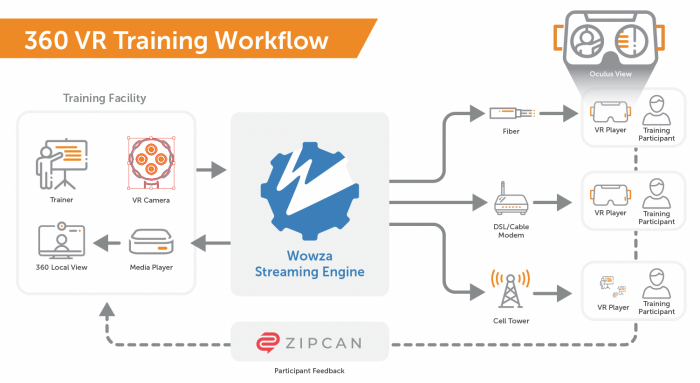Combining Large-Scale Broadcasting With Interactive Video Chat

Today, live entertainment is a two-way street. Even when it comes to routine programming like sports, viewers often engage with multiple screens during a broadcast. Whether at the stadium or at home, your experience might be supplemented by the jumbotron, your smartphone, or even watch party features within a streaming platform.
By integrating interactive video chat into a primary broadcast, today’s content distributors are enhancing the end-user experience. Watch parties that allow groups of friends to cheer on their favorite team are one example of this. Another would be breakout rooms following each presentation during a virtual conference.

Supplementing the live or on-demand broadcast with real-time video and text chat allows for a more immersive digital experience. Beyond that, it creates new monetization opportunities for content distributors in any vertical. You get to chit-chat with colleagues while attending a trade show, so why shouldn’t a virtual trade show allow you to do the same?
Here’s a look at some of the ways companies are combining large-scale broadcasting with real-time video chat across industries.
Virtual and Hybrid Events
The live event landscape transformed last year. Event producers had a choice: go virtual or go by the wayside. Video streaming became an essential technology — but replicating the in-person experience required additional functionality.
Sure, event producers could simply broadcast their events for passive consumption. But why not add a layer of interactivity to boost viewer participation? Organizations that chose to embrace the endless possibilities of streaming laid the framework for future innovation with real-time chat.
Many live event organizations now deliver virtual breakout rooms, watch party features, and expert Q&A sessions. They’re thereby able to and create unique, personalized experiences that put viewers in the driver’s seat.
For instance, a virtual conference could be designed so that audience members could seamlessly transition from viewing the main show to participating in a dynamic breakout room with a handful of individuals at intermission. The small group would have the opportunity to discuss the content from the main stage — a component that’s often missing for remote viewers.
E-Commerce
E-commerce has long leveraged tools like chatbots and personalized recommendations to boost customer interest. But some aspects of the in-store experience go missing when shopping in the digital world.
By fusing online retail with live streaming, today’s retailers are bringing consumers one step closer. Dubbed live commerce or clienteling, this trend helps close the gap between customer and product, drive sales, and increase the average selling price.
Imagine watching a live runway show that allows you to purchase items in real time from the catwalk, while also discussing each look with a stylist. Newsworthy events such as Black Friday, Singles Day, limited edition drops, and product launches would generate even more buzz — while keeping viewers tuned in.
Influencer streaming also plays a role in shoppable video. In China, internet celebrities live stream everything from makeup tutorials to agricultural goods. With video chat functionality supplementing these large-scale broadcasts, viewers who purchased a VIP pass could also ask questions during the broadcast. Likewise, diehard fans could purchase one-to-one chats with their favorite influencer following a streaming event.

Education
Remote learning takes the form of both collaborative video chats and one-to-many lectures. Combining large-scale broadcasting with real-time video checks all the boxes, and shows promise in everything from virtual university settings to specialized training.
Powering education with 360° virtual reality (VR) also makes a lot of sense. It gives everyone a front-row seat, making specialized training that usually takes place in operating rooms or remote locations available to a much larger audience. Participants can control the angle and move around the room, ensuring an individualized experience for each viewer. By adding two-way video to a 360° VR stream, end users could also ask questions and provide other feedback during these broadcasts.

Immersive and Interactive Experiences
Virtual viewers are surrounded by distractions. The cat on the desk, the phone going off, or the temptation to scroll through social media all compete for attention. Creating digital experiences that keep viewers tuned in starts with interactivity and immersion.
For instance, a MasterClass could allow attendees to ask the instructor for additional clarification while viewing the pre-recorded content. Or, a live streaming fitness app could deliver HD video that gave participants the flexibility to create a private group with only their friends and the instructor.
Two-Way Engagement With Wowza
From digital interactive fitness to social media sites like TikTok, interactive streaming is becoming the norm. And Wowza provides the streaming infrastructure, custom development, and third-party tools required to bring them to life.
We’ve been partnering with Zipcan, an embeddable video chat platform, to help our customers architect the solutions described above. The result is an integrated workflow that achieves both scale and interactivity.
Signathon.live, an innovator in sports memorabilia and live signing events, has leveraged our partnership to create virtual fan experiences that deliver star power to your living room.
By adding video conferencing to their virtual event offering, Signathon is driving additional revenue and connecting their community. This also encourages people to stay on their website longer and engage deeper.
Interested in enhancing your offering with a custom solution that combines streaming with real-time chat? Contact us and we’ll discuss how Wowza Professional Services and Zipcan can bring your idea to life.




